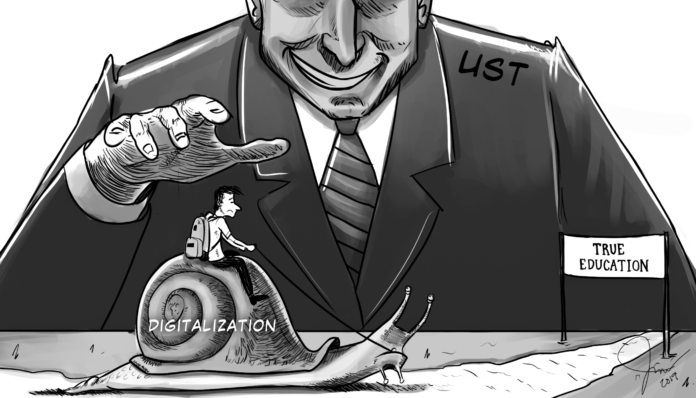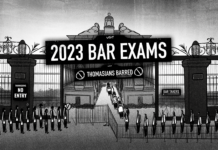ACADEMIC affairs head Cheryl Peralta has admitted to technological inadequacies within the campus system that allegedly militate against the full implementation of the online-aided classroom instruction.
But she has also blamed the problem on the resistance to the new system of “old professors” who presumably aren’t tech-savvy and who stick to their old ways.
But it has been 15 years since UST’s Educational Technology Center (EdTech) launched online courses through the Electronic Learning Access Program (e-Leap) and obviously, EdTech and Peralta should have input the “technological literacy time lag” between the old and new generations in the faculty to UST’s decision this school year to become a “cloud campus.”
Alas, the most advanced cloud campus in this side of Sampaloc has not only seen overcast clouds, but hit deep freeze like the harsh winter being experienced at present by the West as a result of climate change.
At the start of the second semester, some faculty members teaching freshmen courses have told EdTech that based on their experience in the first semester, e-Leap is not exactly a great leap forward but a jurassic leap backward because of the unreliable Internet system on campus. Critics have said, Internet connection on campus through “Veritas” does not reach especially those in the classrooms.
Peralta has ordered teachers to utilize e-Leap and make it 50 percent of instruction, an impossible ratio to achieve vis-a-vis actual face-to-face classroom instruction because of poor Internet. Peralta has acknowledged the poor Internet exposure but still she insists on the same online equity.
But the challenge remains that not all students have the means to access the Internet to participate in these classes.
Should we sacrifice the true essence of learning just to keep up with globalization and modernization of methods in teaching?
While it is good that UST tries to be at par with universities abroad in e-learning, it seems it is doing so just to keep up with the Joneses and, like Freudian penis-envy, for sheer technology-envy. In short, it is trying to use technology just for the sake of using fancy technology and not for education and the needs of a developing nation.
And UST academic officialdom is likewise averse to—or seems ignorant of—the fact that the Philippines is a laggard in Southeast Asia as far as Internet bandwidth is concerned. The Philippines with a population of more than 100 million has a mere 15 megabits per second of Internet compared with the 54 mbps of tiny Singapore (with just 5.8 million people), Malaysia has 20 mbps but its population is only 32 million. Thailand has 17 mbps for a population of 69 million.
At the least, academic planners of UST—many of whom come from the positivistic sciences like Peralta—should have done their homework or at least, should not be intellectually dishonest about Philippine realities that militate against the full use of digital technology. They should likewise be aware of UST realities such as the many dead spots on campus that hamper digitalization.
Burden to students, parents
As it is, digitalization or UST’s pretension of being technologically-savvy, has merely added to the increasing costs of education.
In 2016, the pioneer batch of UST Senior High School (SHS) students were required to have iPads so they could access textbooks electronically. Parents and students raised their eyebrows and had this decision by the inaugural SHS administration not met criticisms, it wouldn’t have retreated and made the requirement optional.
The SHS requirement was stupid, unfair, and ultimately irregular and highly unethical. Philippine textbooks in basic education have always been notoriously defective, so why demand the first batch of SHS to use electronic textbooks by Philippine publishers? If publishers haven’t improved the quality of textbooks for grades 1 to 10, how could the same publishers come up with fool-proof textbooks for the inaugural year of SHS?
And since many parents have been complaining of the extra costs of educating their children because of two more years added to basic education, why force them to buy expensive tech gadgets and, here’s the irregularity, force them to buy from the UST SHS administration who was making such a demand? For an institution that prides itself in ethics, the requirement smacks of impropriety and conflict of interest.
UST planners should have learned from the SHS gaffe, but they obviously did not since they have since required college students and teachers to use e-Leap despite the woeful communications infrastructure on campus.
Outcomes-based education
It is a shame that faculty members are pressured to use e-LEAP as a tool for teaching. They should have the freedom to choose between traditional and electronic methods or mix the two according to a measure or balance that’s their decision to make based on academic freedom.
UST has implemented another problematic pedagogical approach, that is the outcomes-based education (OBE).
The University should not turn a blind eye to the truth that not all courses offered in UST such can use e-learning for effective and full learning. E-learning is best in technology, full science courses, not the liberal arts, arts and humanities, social sciences, languages, and cultural studies.
The fact that UST is Asia’s oldest university should have compelled its leaders and planners to make the necessary distinctions and gradations and to practice prudence and discretion, There’s simply no single pedagogical approach that will apply across the board. There’s no such thing as one-size-fits-all in education. To insist on e-Leap and OBE and for faculty and students to toe the line is not wisdom, but fascism.















